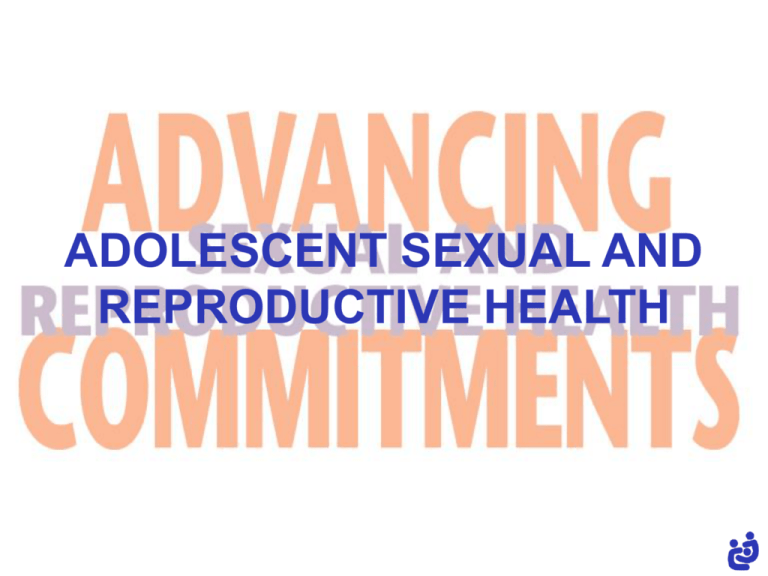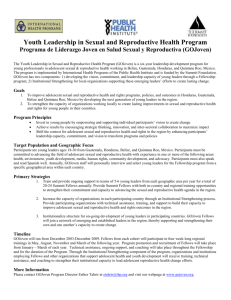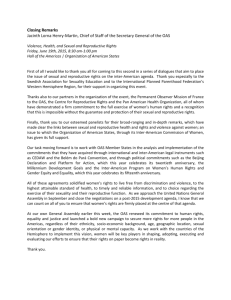
ADOLESCENT SEXUAL AND
REPRODUCTIVE HEALTH
Adolescent sexual and reproductive
health
Adolescents are young people between the ages of 10 and 19.
Adolescent sexual and reproductive health refers to the
physical, mental, and emotional well being of adolescents, and
includes freedom from:
unwanted pregnancy
unsafe abortion
sexually transmitted infections (STIs), including HIV/AIDS
all forms of sexual violence and coercion
More than one billion young people are entering their reproductive
years - the largest generation in history. To reach their potential, young
people must be empowered with the facts and services they need to
make informed reproductive health decisions.
adolescent sexual and reproductive health
(2)
Adolescent sexual and reproductive
health issues: a global perspective
Adolescent girls account for more than 10% of all
births worldwide.
Every year, a quarter of all unsafe abortions —
approximately 5 million — are performed on
adolescent girls aged 15-19.
Girls in sub-Saharan Africa aged 15-19 are 5 times
more likely to have HIV than boys their own age.
Between 40% and 58% of sexual assaults are
committed against girls aged 15 and younger.
adolescent sexual and reproductive health
(3)
Sexual activity among young women,
various regions
In much of the world, sexual activity begins during adolescence — before or within marriage.
90
80
10%
70
45%
60
Have had first intercourse:
50
Within marriage
28%
40
Before marriage
67%
30
48%
38%
20
28%
10
0
Sub-Saharan Africa
Asia, North Africa,
Middle East
Latin America/
Caribbean
Five developed
countries*
*France,
Germany, Great Britain,
Poland, and the U.S.
Reproductive health programs have traditionally been accessible only to married adolescents
and overlooked the needs of unmarried adolescents.
adolescent sexual and reproductive health
(4)
Adolescents need a supportive environment
Ensure access to a minimum of 7 years of education
Provide comprehensive sexual and reproductive health
information and services
Review and revise existing policies that negatively affect
adolescents
Parents, policy makers, educators, and
health care providers should work in
partnership to provide adolescents with the
tools they need to have a healthy and
satisfying adolescence and to become
healthy, productive adults.
adolescent sexual and reproductive health
(5)
Adolescent sexual and reproductive
health education for adolescents must:
Involve young people as key decision-makers in
program design, implementation, and evaluation
Provide comprehensive,
accurate information in a
manner appropriate to their
age group and sex
Address barriers to accessing
health and information services
Empower adolescents to make life choices that are
best for them
adolescent sexual and reproductive health
(6)
Providing adolescents with sexual and
reproductive health education
MYTH
Sexual and reproductive health information promotes
promiscuity and early sexual activity.
REALITY
Sexuality education contributes to:
higher levels of abstinence
greater use of contraception
later initiation of sexual
activity
fewer sexual partners
Sexuality education can help protect young people from some
of the potential risks of sexual activity.*
*Conclusion from a multi-country study carried out by UNAIDS
adolescent sexual and reproductive health
(7)
Essential components of youthfriendly services
Youth-friendly reproductive health
services:
Meet the full range of young people’s
sexual and reproductive health
needs
Involve young people in the
design, implementation, and
evaluation of services
Provide non-judgmental and
confidential counseling
Are accessible and affordable
Provide effective referral linkages
adolescent sexual and reproductive health
(8)
Insert text here
adolescent sexual and reproductive health
(9)





